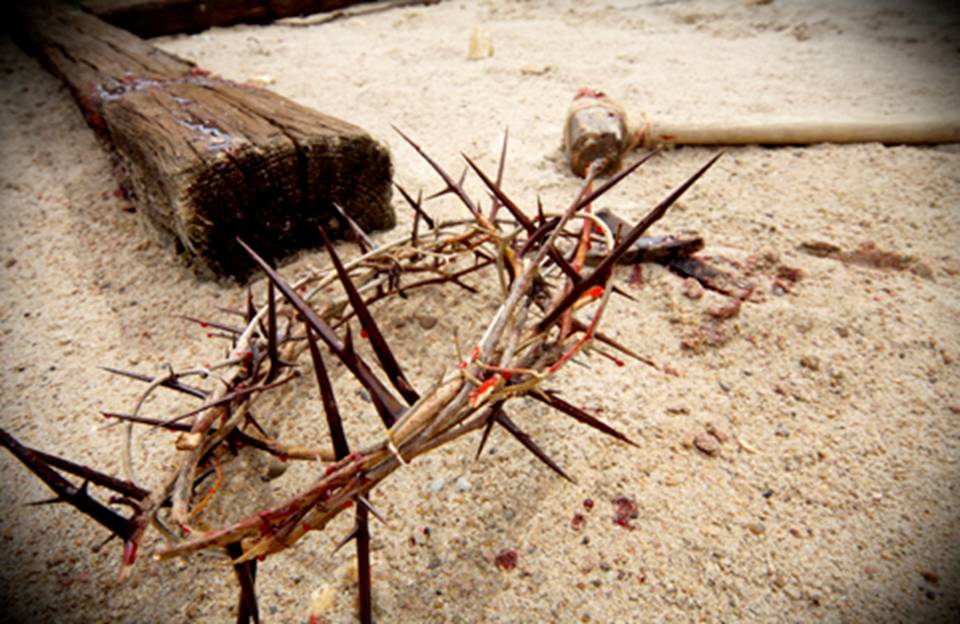Well, It’s another Sunday morning. “For God so loved the world, that he gave his only Son, that whoever believes in him should not perish but have eternal life.” John 3:16 (ESV)
I try to post this every year about this time, it is such a strong reminder of the pain our great Lord suffered for our sins. This is a physicians account of the crucification.
On the day Jesus was to be crucified He was stripped naked and His clothing divided by the Roman guards. This was in fulfillment of Psalm 22:18, “They divide My garments among them, and for My clothing they cast lots.”
The Crucifixion of Jesus was a slow, extremely painful death. Jesus’ knees were flexed at about 45 degrees, and He was forced to bear His weight with the muscles of His thighs, which is not a position which is possible to maintain for more than a few minutes without severe cramps in the muscles of the thighs and calves. Jesus’ weight was borne on His feet, with nails driven through them. As the strength of the muscles of Jesus’ lower limbs tired, the weight of His body had to be transferred to His wrists, His arms, and His shoulders.
Within a few minutes of being placed on the Cross, Jesus’ shoulders were dislocated. Minutes later Jesus’ elbows and wrists became dislocated. The result of these upper limb dislocations is that His arms were 9 inches longer than normal, as clearly shown on the Shroud. In addition prophecy was fulfilled in Psalm 22:14, “I am poured out like water, and all My bones are out of joint.” After Jesus’ wrists, elbows, and shoulders were dislocated, the weight of His body on his upper limbs caused traction forces on the pectoral muscles of His chest wall. These traction forces caused His rib cage to be pulled upwards and outwards, in a most unnatural state. His chest wall was permanently in a position inhalation. In order to breathe out, Jesus had to push down on the nails in His feet to raise His body, and allow His rib cage to move downwards and inwards to release the air from His lungs. The problem was that Jesus could not easily push down on the nails in His feet because the muscles of His legs, bent at 45 degrees, were extremely fatigued and severely cramping. See, unlike all Hollywood movies about the crucifixion, the victim was extremely active. The crucified victim was physiologically forced to move up and down the cross, a distance of about 12 inches, in order to breathe. The process of breathing caused excruciating pain, and total fear of asphyxiation.
As the six hours of the Crucifixion wore on, Jesus was less and less able to bear His weight on His legs, as His thigh and calf muscles became increasingly exhausted. There was increasing dislocation of His wrists, elbows and shoulders, and further elevation of His chest wall, making His breathing more and more difficult along with excruciating pain throughout His body. The movements became less frequent as Jesus became increasingly exhausted, but the terror of imminent death by asphyxiation forced Him to continue in His efforts to breathe. Jesus’ lower limb muscles developed excruciating cramps from the effort of pushing down on His legs, to raise His body, so that He could breathe out.
Jesus was covered in blood and sweat, The blood was a result of the whipping that nearly killed Him, and the sweat as a result of His violent attempts to expire air from His lungs. Throughout all this He was completely naked, and the leaders of the Jews, the crowds, and the thieves on both sides of Him were jeering, swearing and laughing at Him.
Because Jesus could not breath properly, He was in hypo-ventilation (inadequate ventilation). His blood oxygen level began to fall, and He developed hypoxia (low blood oxygen). Also, because of His restricted respiratory movements, His blood carbon dioxide (CO2) level began to rise. This rising CO2 level caused His heart to beat faster in order to increase the delivery of oxygen and the removal of CO2. The Respiratory Center in Jesus’ brain sent urgent messages to his lungs to breathe faster, and Jesus began to pant. Jesus’ brain demanded that He take deeper breaths, and He involuntarily moved up and down the Cross much faster, despite the excruciating pain. The agonizing movements spontaneously started several times a minute. However, due to the nailing of Jesus to the Cross and His increasing exhaustion, He was unable to provide more oxygen to His oxygen-starved body causing His heart to beat faster and faster, and Jesus developed tachycardia. His pulse rate was probably about 220 beats/minute.
Jesus hadn’t drunk anything for 15 hours, and Jesus had endured a scourging which nearly killed Him. He was bleeding from all over His body following the scourging, the crown of thorns, the nails in His wrists and feet, and the lacerations following His beatings and falls. Jesus was already very dehydrated, and His blood pressure fell alarmingly. His blood pressure was probably about 80/50. He was in First Degree Shock, by about noon Jesus’ heart probably began to fail. Jesus’ lungs probably began to fill up with fluid. Jesus was in heart failure and respiratory failure.
Jesus said, “I thirst” because His body was crying out for fluids. Jesus was in desperate need of an intravenous infusion of blood and plasma to save His life. Jesus could not breathe properly and was slowly suffocating to death.
At this stage Jesus began to developed a collection of plasma and blood around His heart. This fluid around His heart caused cardiac tamponade (Jesus’ heart couldn’t beat properly). Because of the increasing physiological demands on Jesus’ heart, Jesus probably eventually sustained cardiac rupture. His heart literally burst. This was probably the cause of His death.
To slow the process of death the soldiers put a small wooden seat on the Cross, which would allow Jesus the “privilege” putting His weight on his sacrum. The effect of this was that it could take up to nine days to die on a Cross. When the Romans wanted to expedite death they would simply break the legs of the victim, causing the victim to suffocate in a matter of minutes.
At three o’clock in the afternoon Jesus said, “It is finished.” At that moment, He gave up His Spirit, and He died. When the soldiers came to Jesus to break His legs, He was already dead. Not a bone of His body was broken, in fulfillment of prophecy (above). Jesus died after six hours of the most excruciating and terrifying torture ever invented so that people like you and me could go to Heaven. All He Asks You is to Love Him, Your Lord, Your God with all your heart and with all your soul and with all your strength and with all your mind. Can you do this for Him? Know this, God truly loves each and every one of you and so do I.






